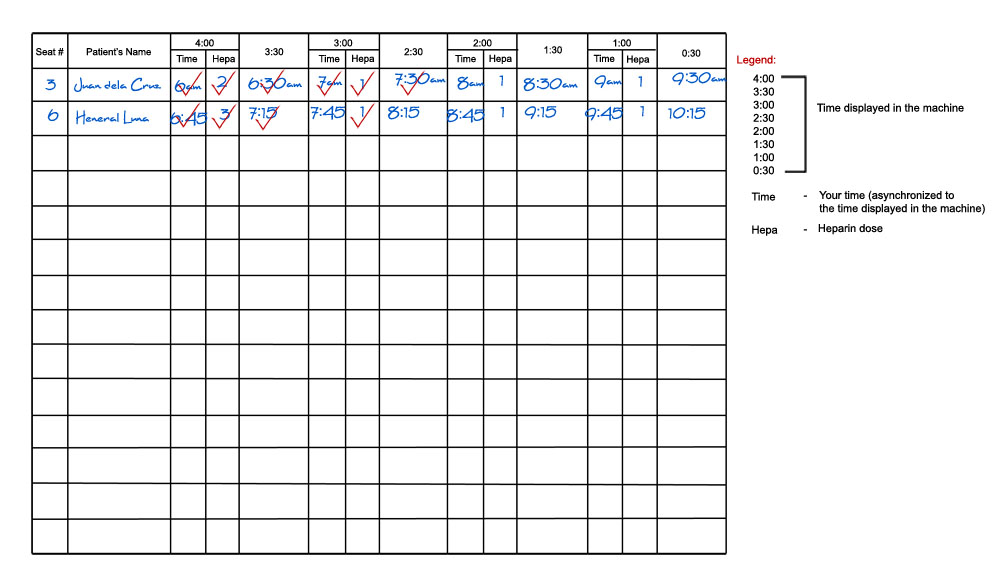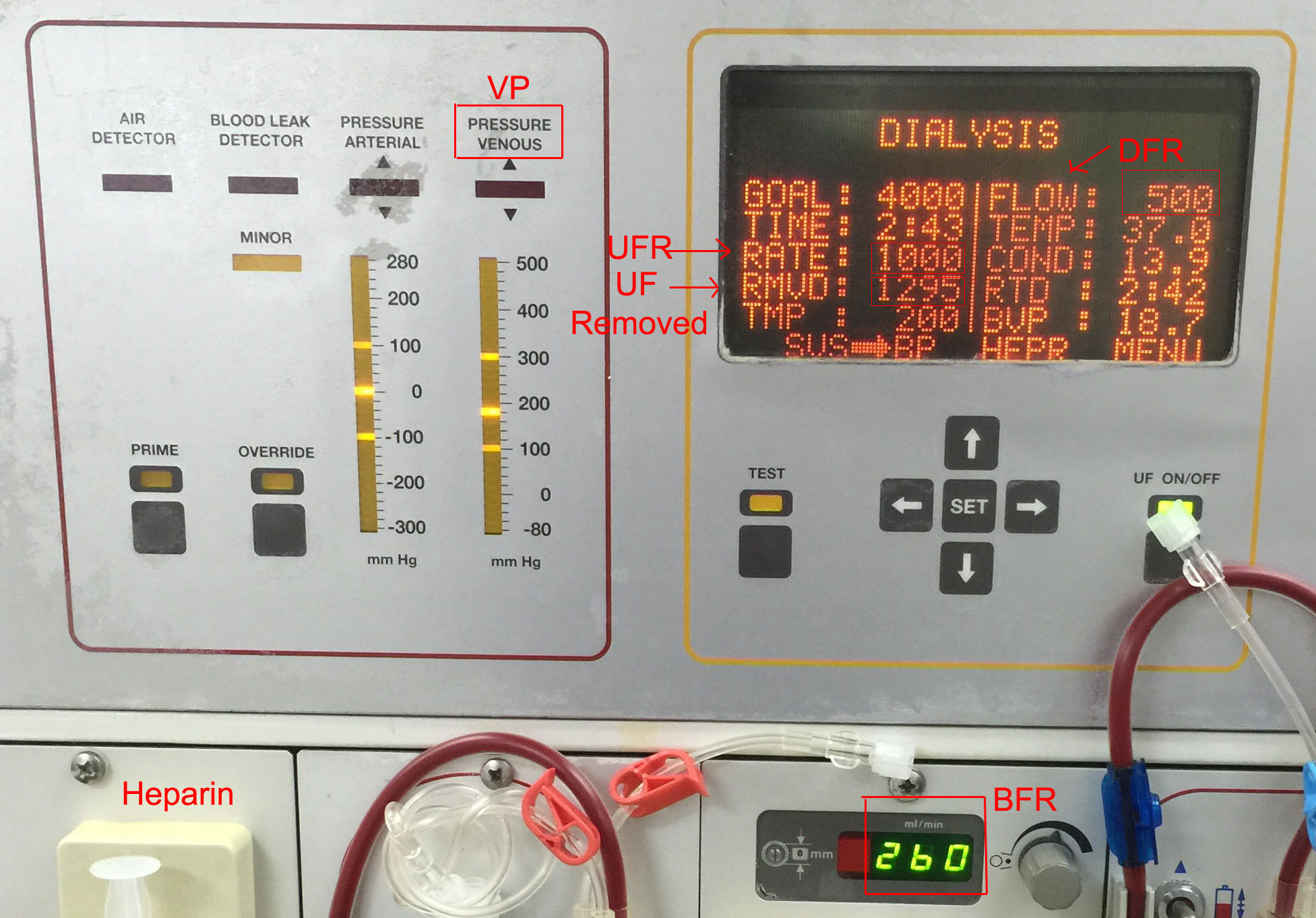
Download Hemodialysis Monitoring Time Tracker Checklist
DownloadHemodialysis Monitoring Time Tracker Checklist Printable
I’m now at my second module in my Nephrology nurse training which means we’re now in the the clinical setting applying the lessons learned and mastering the needed skills. Previously working from a hospital, clinic or center is a total different environment and the first thing I need to deal again is the “vital signs”.haha Yup, when you are so accustomed to the functional nursing being practiced in the hospital with the nurse attendants assigned to take the vital signs, you come to a point questioning yourself if you still remember the whole process.haha So, you can imagine the horror during my first day seeing the staff nurses taking the vital signs themselves.lol
What surprises me is the fact that it wasn’t that boring at all unlike in the hospital. Although it’s obviously a routine and would soon end up boring, the number of patients needed to be monitored within a set time is challenging enough and when you missed, it even challenges you more that definitely, you still need improvement. By the way, this is an obsessive compulsive talking. I hate seeing blanks in my monitoring sheet because it would tell me that I’m not that good or perfect.haha So what I did, I came up with a Hemodialysis Monitoring Time Tracker Checklist.
Monitoring Time Tracker Checklist VS Monitoring Sheet
Unlike in a typical monitoring sheet, monitoring time tracker checklist does not require you to input the values. It mainly consists of the different set of times for you to be able to track and monitor within schedule. Instead, you only put the set or scheduled time and a check mark as soon as you are done monitoring, making it easier for you to spot the patients you still need to monitor.
Monitoring Sheet
In a hemodialysis setting, the V/S you need to get are: BP, PR, O2 Sat, Temp and Weight while the rest can be copied from the machine and the display screen that includes: BFR, VP, UF Removed, UF rate, DFR and Heparin dose given.
- BFR (Blood Flow Rate)
BFR as prescribed by the doctor is set and maintained by the nephrology nurse for the blood pump to force blood through the dialyzer and back to the patient’s body. Furthermore, it is our responsibility to let the patient know how much blood is being processed.
- BFR depends on the size of the patient’s access, the tubing, and the needles.
- Fistulas and grafts normally have better blood flow rates than catheters. To compromise for a slower blood flow rate, patients with catheters may be prescribed a longer treatment and a high flux dialyzer.
- The higher the blood flow rate is, the better the result and clearance.
- VP (Venous Pressure)
VP is the pressure produced between the dialyzer and the patient’s access. If the venous pressure increases from week to week of treatment, it could possibly mean a narrowing of the blood vessels in the patient’s access. If caught early by the dialysis technician, this can be fixed. Thus the venous pressure alarm can sound when:
- A needle infiltrates the blood vessel wall.
- The blood tubing kinks.
- The blood tubing separates from the dialyzer.
- The blood vessel in the access narrows.
- The blood pump speed is too fast or too slow.
- The needle dislodges.
- UF Removed / Volume Removed
The total volume of fluid to be removed is calculated based on the excess of the patient’s dry weight. Ideally, the goal is to target a weight where the patient will be normally hydrated, where he doesn’t feel thirsty, and feel comfortable. Master the the UF Goal calculation here.
- UF (Ultrafiltration) Rate
The process of removing fluid is called ultrafiltration (UF). Since pressure is always higher on the blood side of the dialyzer, fluid moves out of the blood and across the dialyzer membrane. How fast and how much fluid is removed is the ultrafiltration rate.
- DFR (Dialysate Flow Rate)
While this measure plays a minimal role in the determination of clearance efficiency, the rate of dialysate flow impacts the amount of cleaning that happens. Dialysate is the fluid that surrounds the blood compartment of the dialyzer, which acts as an artificial kidney and replaces normal functions of the natural organ. This means that the more dialysate used the more toxins removed from the blood. The dialysate flow rate can be controlled by the machine based on a setting maintained by the dialysis technician.
- Heparin Dose
This will be explained in details in a different post.
Monitoring Time Tracker Checklist
From how I named it:
Monitoring Time: It consists mainly the scheduled time of your monitoring. There are actually two different times: (1) time reflected on the display screen – 4:00, 3:30, 3:00… (2) clock time asynchronized to the time displayed on screen – this is the time the treatment has started followed by 30min to 1hr interval monitoring.
Tracker: It keeps you on tracked within schedule.
Checklist: Putting a checkmark right after monitoring makes it easier to know when is the next due and who is the next patient for monitoring.
To fill up:
- First fill up seat # and patient’s name.
- Input the time the tratment has started on the column under 4:00 and time.
- Fill up the rest of the column under 3:30, 3:00, 2:30… Following its respective interval 30 minutes. From the image, treatment started at 6:00 so the next schedule for monitoring will be 6:30 and so on.
- Fill up Heparin dose as prescribed. Usually it is prescribed: 3:1ml, 2:1ml and 1:.5m for low dose.
- Put a checkmark every after monitoring. As you can see with Heneral Luna’s row, Heparin is checked first since usually (especially the last dose) we make sure to give it an hour before since it works about that duration.
Here you can download the Hemodialysis Monitoring Time Tracker Checklist in PDF.




